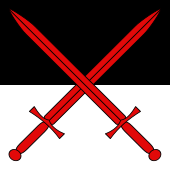Reich racing flag
The imperial racing flag was carried by the imperial marshal or his troops next to the imperial banner of the Holy Roman Empire of the emperor. She describes herself: Divided by black and silver, two diagonally crossed red swords .
Word origin
The term racing flag refers to the custom, when enfeoffing a prince, to ride around the scaffolding on which the emperor sat three times in full hunt. Among other things, the so-called racing flag was used here. The circumnavigation was done first without a flag, then with the racing flag, and finally with the feudal flag with the coat of arms of the countries to be received as fiefs. This process was also known as “renaming”.
Function and history
It is the personal standard of the Roman-German emperor and shows him in battle, in contrast to the black and yellow imperial storm flag wielded by the foreman .
The Erzmarschallamt had the Elector of Saxony held. The red swords on black and white, also known as “ Kurschwerter ” in Saxony, were thus included in the coat of arms of the Electorate of Saxony . The Pappenheim family presumably held the Reichsherbmarschallamt (“Vicemarescallus”) as the deputy of the Archmarschall from 1100, and from 1141 onwards. This coat of arms can also be found in their quartered coat of arms.
The imperial racing flag, as an ornament of the right helmet, and also quartered in the coat of arms of a Marshal von Pappenheim . Johann Siebmacher : New Wappenbuch. 1605
Electorate of Saxony until 1806: the Reichsrennfahne in the right gap (left Saxony , the coat of arms is on the black and gold colors of the Reichssturmfahne / Reichsbanner )
Coat of arms of the Duchy of Saxony-Lauenburg (in use from 1435 to 1507 and reintroduced from 1671 to 1689)
Other important flags of the empire

|
As a rider standarte was originally square Reich Striker flag as Reichsbanner the black imperial eagle in a golden field and had a top fixed to the banners, long red " Schwenkel ". She was later also depicted with a double-headed eagle. Or around 1692 briefly with a black eagle in a blue field, when the Dukes of Braunschweig-Lüneburg claimed the office of Reichssturmfähnrichs to establish the ninth cure . |
|
|
The flag of the crusader era : the silver cross on red. Flag of the Order of St. John , which was later probably interpreted as a symbol of belonging to the Reich |
|
|
Reichsbanner : In gold a black eagle, more recently with a double-headed eagle |
|
|
Since the 16th century, the army of modern times has also used the image of the Madonna as a standard (here: Bavarian Madonna, Catholic League , Thirty Years War ) |
literature
- Ernst Schubert : King and Empire. Studies on the late medieval German constitutional history (= publications of the Max Planck Institute for History, Vol. 63). Vandenhoeck & Ruprecht, Göttingen 1979, ISBN 3-525-35375-8 , pp. 358-366: King and Empire in the heraldic language of colors. (At the same time: Erlangen-Nürnberg, Univ., Habil.-Schr.).
Web links
Individual evidence
- ^ Wording of the blazon for today's coat of arms of the Wittenberg district
- ^ Pierer's Universal-Lexikon, Volume 2. Altenburg 1857, p. 591.
- ↑ http://www.welt-der-wappen.de/Heraldik/rennfahne.htm
- ↑ flag [1]. In: Meyers Großes Konversations-Lexikon . Volume 6. Leipzig 1906, pp. 267-268. (zeno.org)
- ↑ Peter Diem: Red-White-Red through the centuries. The true story of the Austrian colors. (also pdf ) Retrieved May 15, 2009 .
- ^ Alfred Mell: The flags of the Austrian soldiers through the ages. Bergland, Vienna 1962, p. 29 - after Diem




